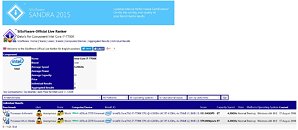Tuesday, August 30th 2016

Intel Core i7-7700K "Kaby Lake" SANDRA Scores Surface
Someone with access to a Core i7-7700K "Kaby Lake" processor and an ASRock Z270-Extreme4 motherboard put the chip through SiSoft SANDRA 2015 CPU tests. Engineering sample or not, the clock speeds of the chip appear to check out with those of the lineup as we know it. The core ticks at 4.20 GHz, with a maximum Turbo Boost frequency of 4.50 GHz. You also get 8 MB of L3 cache, and HyperThreading. The benchmark confirms that Intel is working on a new platform refresh chipset, with the Z270 chipset succeeding the existing Z170. Existing LGA1151 could support the new chips, with BIOS updates.
At its stock speeds, the i7-7700K churns out a SANDRA 2015 "Processor Arithmetic" score of 151.94 GOPS. Its "Processor Multimedia" score yielded is 379.8 Mpix/s. To put things in perspective, a Core i7-6700K "Skylake" processor running at its stock speed of 4.00 GHz core with 4.20 GHz Turbo Boost typically yields 140.88 GOPS in "Processor Arithmetic" and 353.8 Mpix/s in "Processor Multimedia" tests, according to LegitReviews. Intel is expected to launch the 7th generation Core processor family, alongside the 200 series chipset, later this year. Kaby Lake is Intel's third CPU micro-architecture for the 14 nm process, after "Skylake" and "Broadwell."
Source:
Reddit
At its stock speeds, the i7-7700K churns out a SANDRA 2015 "Processor Arithmetic" score of 151.94 GOPS. Its "Processor Multimedia" score yielded is 379.8 Mpix/s. To put things in perspective, a Core i7-6700K "Skylake" processor running at its stock speed of 4.00 GHz core with 4.20 GHz Turbo Boost typically yields 140.88 GOPS in "Processor Arithmetic" and 353.8 Mpix/s in "Processor Multimedia" tests, according to LegitReviews. Intel is expected to launch the 7th generation Core processor family, alongside the 200 series chipset, later this year. Kaby Lake is Intel's third CPU micro-architecture for the 14 nm process, after "Skylake" and "Broadwell."

57 Comments on Intel Core i7-7700K "Kaby Lake" SANDRA Scores Surface
Comparing the Xeon versions of them we see that the E3 1275 V5at 3,6 Ghz with IGP is a 80W part, while the E3 1275 V6 at 3,8 with IGP is a 78 W part, add inn the anemic IPC increase at approximately 2,5 % and this seams like one massive let down performance wise.
It's all marketing at this point with the second round cpu.. Clearly Intel didn't make enough money off of Devil's Canyon 4790 to offer a 6790k solution, but honestly who is going to upgrade from a 6xxx series cpu to a new faster clocked 6790 cpu? Not enough to matter... but consumers will see the 7xxx series and say oh I need that because it's faster due to the higher cpu name.. lol
But me's going backwards to Haswell-E path for more cores.
It all about their foundry than chip engineering for like a while now.
People don't realise that most products get an upgrade/change every year. Every year there's a new model of the same car, tv, dryer, fridge, cellphone whatever you can think of. You want to hate on those brands too?
You have to understand AMD fans are basically victims now, lashing out at a free market that doesn't seem to care as much about AMD as they do.
We will be more excited with motherboards than with performance of Processors.
Motherboards are my favorite hardware.
Now that I think about it, I don't even need the performance, I am mostly upgrading because of the platform features.
"instructions per cycle (IPC) is one aspect of a processor's performance: the average number of instructions executed for each clock cycle."
That means the only way to measure IPC of Kaby Lake against Skylake is at the same CPU frequency. Since Kaby Lake is simply made on a new 14nm+ node, but the underlying CPU architecture is 100% identical (GPU improvements are irrelevant here unless measuring 4K encoding/decoding acceleration), the IPC of Kaby Lake and Skylake will be identical at the same clocks. AnandTech confirms:
"We are being told that the underlying microarchitecture for Kaby Lake is the same as Skylake, and that the frequency adjustments from the new process, along with features such as Speed Shift v2 and the new fixed function media codecs, account for the performance improvements as well as battery life increases when dealing with 4K content.
For users that speak in pure IPC, this may/may not be a shock. Without further detail, Intel is implying that Kaby Lake will have the same IPC as Skylake, however it will operate with a better power efficiency (same frequency at lower power, or higher frequency at same power) and for media consumption there will be more idle CPU cycles with lower power drain. The latter makes sense for mobile devices such as tablets, 2-in-1s and notebooks, or for power conscious users, but paints a static picture for the future of the desktop platform in January if the user only gets another 200-400 MHz in base frequencies."
If you want to make any argument for an improved experience on the desktop against i7 6700K, it will either have to come from Kaby Lake's higher overclocking headroom, which we will not know about until January, or from system response time due to SpeedShift v2.
In my personal opinion, anyone on 2600K/3770K 4.5Ghz or faster who has not upgraded to i7 6700K starting August 2015 has little to no incentive to upgrade to Kaby Lake or even Cannon Lake. The most logical upgrade for those who skipped Skylake is the next true architecture with Ice Lake or at minimum Skylake-X on 2066.